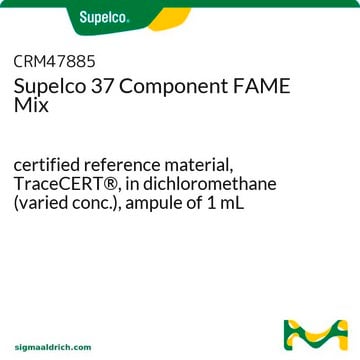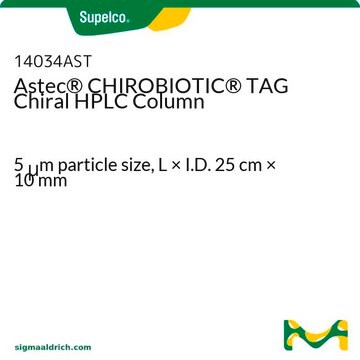53023AST
Astec® CLC-D Chiral (5 μm) HPLC Columns
L × I.D. 15 cm × 4.6 mm, HPLC Column
Synonym(e):
Chiral Separation CLC-D Column
Anmeldenzur Ansicht organisationsspezifischer und vertraglich vereinbarter Preise
Alle Fotos(1)
About This Item
UNSPSC-Code:
41115700
eCl@ss:
32110501
NACRES:
SB.52
Empfohlene Produkte
Produktbezeichnung
Astec® CLC-D Chiral HPLC Column, 5 μm particle size, L × I.D. 15 cm × 4.6 mm
Materialien
stainless steel column
Qualitätsniveau
Agentur
suitable for USP L32
Produktlinie
Astec®
Verpackung
pkg of 1 ea
Hersteller/Markenname
Astec®
Parameter
0-50 °C temperature
172 bar pressure (2500 psi)
Methode(n)
HPLC: suitable
L × ID
15 cm × 4.6 mm
Matrix
fully porous particle
Aktive Matrixgruppe
chiral bidentate ligand (D-form), requires 5 mM CuSO4 phase
Partikelgröße
5 μm
Porengröße
100 Å
Betriebs-pH-Wert
3.5-7
Trenntechnik
chiral
Allgemeine Beschreibung
CLC columns use the copper ligand concept described by Davankov to effect enantiomer separation (1). The method uses a small, chiral bidentate ligand attached to the silica surface and a copper sulphate-containing mobile phase. The copper ions coordinate with the chiral selector on the stationary phase and carboxylic acid functional groups on the analytes to form transient diastereomeric complexes in solution. The technique also has the advantage of giving small acids with no UV chromophore a strong 254 nm signal. CLC columns are ideal for analysis of hydroxy acids, like lactic, malic, tartaric and mandelic acids, amino acids, other amines and bi-functional racemates, like amino alcohols. Proline and aspartic acid are particularly suited for low-level detection on the CLC column since the copper complex is detected at 254 nm UV. Both can be resolved on the CLC-D or CLC-L in 5 mM CuSO4 with the usual reversal of elution order from the CLC-D to CLC-L. In theory, any analyte that can complete the coordination with the copper ion can be resolved. Two versions of the column provide elution order reversal. On the CLC-D column, the L enantiomer generally elutes before D, with the exception of tartaric acid. The reverse is true on the CLC-L column where D elutes before L.
Features:
(1) Davankov, V. A.; Rogozhin, S. V. Ligand chromatography as a novel method for the investigation of mixed complexes: Stereoselective effects in a-amino acid copper(II) complexes. J. Chrom. A. 1971, 60, 284-312.
Features:
- Separates α-hydroxy carboxylic acids, amino acids and other α-bifunctional compounds
- High selectivity with simple mobile phases
- Copper complex gives strong UV 254 nm signal
- Simple reversal of elution order, CLC-L vs. CLC-D
- Excellent reproducibility
(1) Davankov, V. A.; Rogozhin, S. V. Ligand chromatography as a novel method for the investigation of mixed complexes: Stereoselective effects in a-amino acid copper(II) complexes. J. Chrom. A. 1971, 60, 284-312.
Rechtliche Hinweise
Astec is a registered trademark of Merck KGaA, Darmstadt, Germany
Hier finden Sie alle aktuellen Versionen:
Besitzen Sie dieses Produkt bereits?
In der Dokumentenbibliothek finden Sie die Dokumentation zu den Produkten, die Sie kürzlich erworben haben.
Badal C Saha et al.
Biotechnology and bioengineering, 82(7), 864-871 (2003-04-18)
Lactobacillus intermedius B-3693 was selected as a good producer of mannitol from fructose after screening 72 bacterial strains. The bacterium produced mannitol, lactic acid, and acetic acid from fructose in pH-controlled batch fermentation. Typical yields of mannitol, lactic acid, and
Enantiomeric impurities in chiral catalysts, auxiliaries, synthons and resolving agents. Part 2
Armstrong, Daniel W., et al.
Tetrahedron Asymmetry, 10 (1), 37-60 (1999)
Chromatograms
application for HPLCapplication for HPLCUnser Team von Wissenschaftlern verfügt über Erfahrung in allen Forschungsbereichen einschließlich Life Science, Materialwissenschaften, chemischer Synthese, Chromatographie, Analytik und vielen mehr..
Setzen Sie sich mit dem technischen Dienst in Verbindung.






